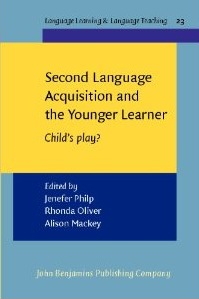December 2010 – Volume 14, Number 3
Second Language Acquisition and Younger Learner: Child’s Play? |
|||
| Author: | J. Philip, R. Oliver, and A. Mackey (2008) |  |
|
| Publisher: | Philadelphia, PA: John Benjamins Publishing Company | ||
| Pages | ISBN | Price | |
|---|---|---|---|
| 335 pages | 978-9027219848 (Hb; alk. Paper-hardcopy) |
$54 U.S. | |
In Second Language Acquisition and Younger Learner: Child’s Play? , Philip, Oliver, and Mackey present an edited volume consisting of twelve chapters that combine theoretical and empirical studies centered around younger learners and language acquisition.
The initial part of the book serves as the introduction to SLA theory and unique nature of younger learners’ acquisition by reviewing some major issues and approaches of child SLA to argue that child SLA should not be underestimated as “play.”Instead, younger learners acquire the target language in distinct stages and through social interaction both on the playground and in their communities and schools.
The first section, “Characteristics of SLA”, includes two chapters underlining the importance of linguistic, cognitive and social factors among different age groups of children. Chapter One focuses on children aged 2-7 year-old and defines the process of SLA of them as distinct from adolescence, or adults in terms of both grammatical and pragmatic features in formal and instructional settings where children undertakes social roles themselves. Chapter Two similarly emphasizes linguistic, cognitive and social factors of second language learning, and further searches on how morphsyntax feature is learned by learners of different ages. Both chapters offer rich theoretical knowledge and various implications for child SLA pedagogy.
Section Two follows the two introductory chapters with the notion of “Instructed language learning in the early years of education” by carrying the issue to instructional settings and dealing with school-aged children from kindergarten to 6th grade . The four chapters in Section Two shed light on culture and interaction within school context and how relationships, affiliations and interactions between adults, peers and teachers all these parties contribute to the development of language.
Section Three treats issues of young adolescents’ SLA while attending junior high school and high school and clarifies the role of instruction while learning second and foreign languages in school contexts. Teachers’ roles in learning process are also emphasized as an additional concern besides peers and more abstract knowledge is tried to be conveyed parallel with the cognitive developmental stage of the subjects. The volume concludes with Section Four—an ensemble of studies of SLA at home and in school/community.
Child SLA merits more attention. One of the strengths of the volume is in the editors’ orchestration of the volume and their ability to balance both research and theory in the book’s various sections.
Researchers and students who are interested in SLA can easily read and benefit from the volume. Moreover, teachers of younger language learners can apply theories and finding into practice. With its well-grounded theory and methodology and orderly presentation of the chapters, this book contributes to language pedagogy and provides new directions for future practice and research.
Reviewed by
Nurdan Armutcu
Mersin University, Mersin, Turkey
<nurdanarmutcu![]() hotmail.com>
hotmail.com>
| © Copyright rests with authors. Please cite TESL-EJ appropriately.
Editor’s Note: The HTML version contains no page numbers. Please use the PDF version of this article for citations. |

